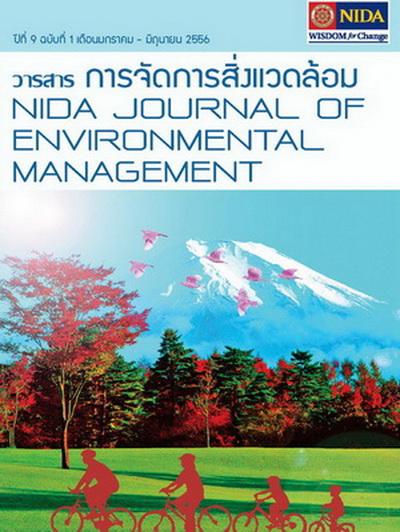การประเมินความเสี่ยงจากการสัมผัสสารบีเทคผ่านทางการหายใจของพนักงานเก็บค่าผ่านทางพิเศษ ในเขตกรุงเทพมหานคร
บทคัดย่อ
บทคัดย่อ
งาน วิจัยนี้เป็นการศึกษาความเสี่ยงต่อสุขภาพของพนักงานเก็บค่าผ่านทางพิเศษใน เขตกรุงเทพมหานครที่รับสัมผัสสารบีเทค (เบนซิน โทลูอีน เอทิลเบนซิน และไซลีน) ผ่านทางการหายใจ พื้นที่ศึกษาคือด่านบางนาและอโศก 4 ทำการเก็บตัวอย่างระหว่างการทำงาน 8 ชั่วโมง (6.00 น. – 14.00 น.) ในวันศุกร์และวันอาทิตย์ในฤดูฝนและฤดูแล้งฝนของปี พ.ศ. 2554 – 2555 โดยใช้หลอด Charcoal glass tube ต่อเข้ากับเครื่องปั๊มเก็บตัวอย่างอากาศชนิดพกพาด้วยอัตราการไหลเท่ากับ 100 ml/min และวิเคราะห์ตัวอย่างด้วยเครื่อง GC/FID ความเข้มข้นเฉลี่ยของสารเบนซิน โทลูอีน เอทิลเบนซิน เมตาไซลีน พาราไซลีน และออโธไซ-ลีน ที่พนักงานได้รับสัมผัสอยู่ในช่วง 9.40 - 221.78, 54.20 - 409.99, 3.25 - 58.84, 6.43 - 79.30 และ 3.20 - 23.72 µg/m3 ตามลำดับ ผลการประเมินความเสี่ยงพบว่า ค่า 95% Confidence interval ของค่าความเสี่ยงของการเกิดมะเร็ง (Lifetime cancer risks) ของสารเบนซินและเอทิลเบนซินมีค่าเท่ากับ 6.93 × 10-5 - 1.41 × 10-4 และ 2.15 × 10-6- 4.52 × 10-6 ตามลำดับ ซึ่งเกินค่าที่ยอมรับได้ (1 × 10-6) สำหรับสารที่ไม่ก่อให้เกิดมะเร็งได้แก่ โทลูอีน เมตาพาราไซลีน และออโธไซลีน มีค่า hazard quotients น้อยกว่า 1 แสดงว่าการสัมผัสสารกลุ่มนี้ยังไม่มีความเสี่ยงของการเกิดโรคอื่นๆ ที่เกี่ยวข้อง
คำสำคัญ: การประเมินความเสี่ยง; การรับสัมผัสผ่านทางการหายใจ; บีเทค;
พนักงานเก็บค่าผ่านทางพิเศษ
Abstract
The aim of this study was to assess the risk levels of tollway station workers in Bangkok exposed to BTEX (benzene, toluene, ethylbenzene and xylene) via inhalation. The tollway stations selected for this study were Bangna and Asoke 4 stations, Bangkok, Thailand. The sampling was carried out during 8 work hours (6 AM – 2 PM) on Friday and Sunday in the wet and dry season of the years 2011 - 2012. BTEX was collected by using a charcoal glass tube connected to a personal air pump with an air flow rate of 100 ml/min and the sample was analyzed by GC–FID. The average concentrations of the worker’s exposure to benzene, toluene, ethylbenzene, m,p-xylene and o-xylene were in the range of 9.40 - 221.78, 54.20 - 409.99, 3.25 - 58.84, 6.43 - 79.30 and 3.20 - 23.72 µg/m3,respectively. Regarding the lifetime cancer risks to the workers, the results showed a 95% confidence interval of 6.93 × 10-5 - 1.41 × 10-4 for benzene, and 2.15 × 10-6 - 4.52 × 10-6 for ethylbenzene, which were higher than the acceptable risks (1 x 10-6), whereas the hazard quotients of non-carcinogenic compounds (toluene m,p-xylene and o-xylene) were in total less than 1, which indicated that there were no health risks of concern.
Keywords: Risk Assessment; Inhalation Exposure; BTEX; Tollway Station Workers



